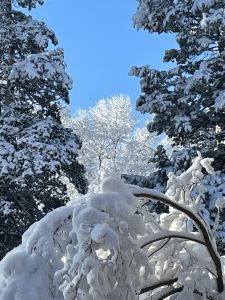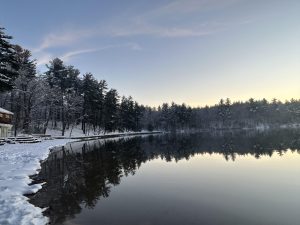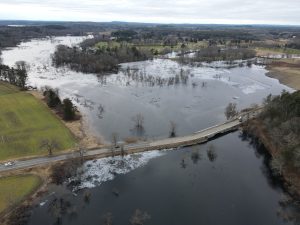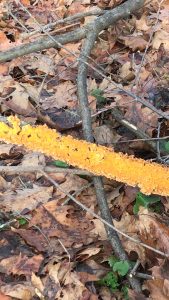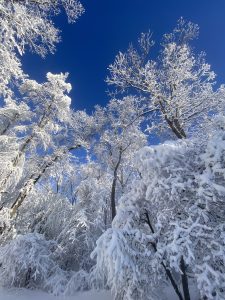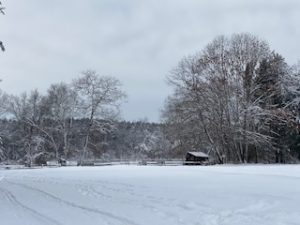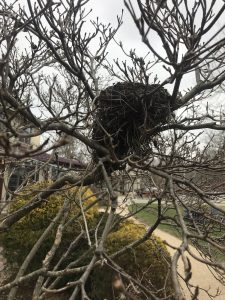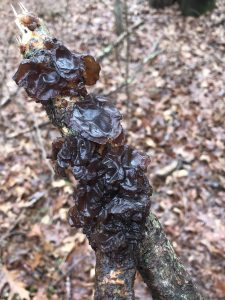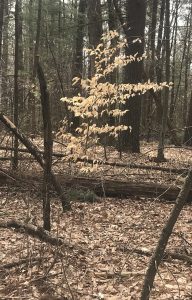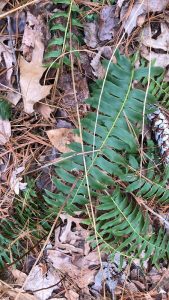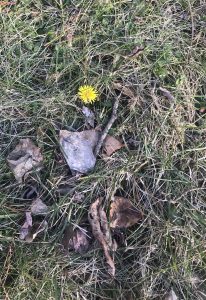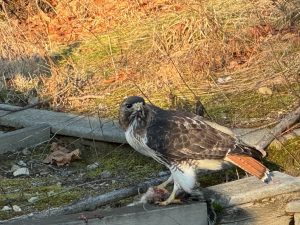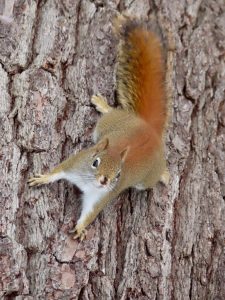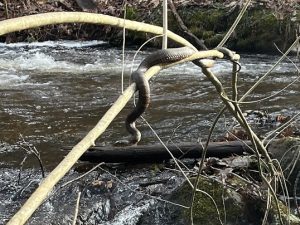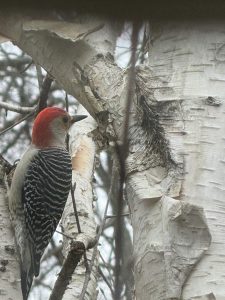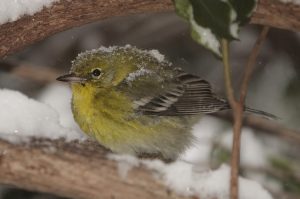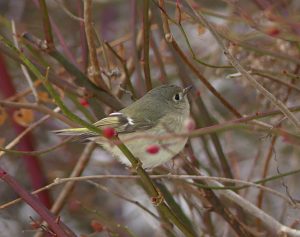Written by Gwyn Loud for the Lincoln Land Conservation Trust. She welcomes your sightings and questions at 781-259-8690 or gwynloud555@gmail.com
Climate change and El Nino have combined to give us unsettled weather and much more than average rainfall over the past month. The ground is saturated and some homeowners are dealing with wet basements, while streams and ponds are very full or flooding. We had a Nor’easter on December 18, with heavy rain and winds and our first significant snowfall – about 8” at my house- came on January 6-7. The snow was wet and heavy and, while beautiful, did a lot of damage to trees, toppling some, breaking branches, and causing power outages. The snow disappeared in heavy rain in a couple of days, and then we were into “spring” on Jan. 13, up to 59℉! According to NOAA’s U.S. Winter Outlook (see link below) an El Nino year means that winter will be warmer than average in the northern continental US. We’ll find out! As this column goes to press, there is more snow on the ground and we are in days of bitter cold.
Winter is the season to appreciate the “skeletons” of trees, their varied shapes, heights, unique bark, and patterns of branching. Oaks and beeches still cling to a few dead leaves, a phenomenon which botanists call marcescence. There are several theories as to why this happens (see link below). This is also an opportune time to notice old birds’ nests. When walking in the woods we can walk quietly now, no longer hearing our feet crunching on dried leaves. The leaves are wet from all the rain and gradually decomposing, enriching the soil. We may notice odd-looking bulbous growths on tree trunks, called burls. Quoting naturalist Mary Holland, “Most burls begin as galls, abnormal growths also found on herbaceous plants caused by a fungus, bacterium, or egg-laying insects. Their growth is abnormally fast, much faster than the tree on which they form. Burls do not kill trees although they may weaken the structure of the trunk. They are much sought after by woodworkers because of the unique beauty of the grain of the wood inside them.”
Although the general landscape shows a palette of browns and grays, there is still plenty of green to be seen, whether in grass, conifers, moss, a few ferns, and even garlic mustard. Snowdrops have been blooming in a sunny spot by my house for a month and a hardy dandelion flowered on the lawn. In late January I shall pick forsythia branches to bring indoors, where the warmth will cause the buds to flower, providing a cheerful harbinger of spring.
Coyotes are being reported from many parts of town, which is not surprising because late January to early March is their breeding season, when they are more active. Will Leona, Lincoln’s Land Steward/Ranger, writes as follows: “There has been a bit of an uptick in coyote sightings being reported. Especially around farm fields or areas where food sources or rodents are readily available. We’ve had several calls from concerned residents who fear being in such close proximity to the coyotes. We have been trying to help people understand that this is typical behavior of coyotes as they are looking for whatever food sources are still present and as they have been expanding more in suburban areas. Hikers should be loud and bold, announcing their presence and not running from the coyotes. Dogs should be put on leash at that point as well. We spoke to Mass Wildlife and the Environmental police, who both urge residents to check out the website resources on coyotes or call Mass Wildlife headquarters to speak with a wildlife biologist if they need further clarification.” The Conservation Department has a flier listing helpful websites relating to coyotes. Tia Pinney, staff naturalist at Drumlin Farm, wrote, “There are three adult coyotes that have settled into Boyce field. They can be seen quite regularly as they are very human habituated. I saw one take a rodent out of the compost heap one day.” A partially-eaten deer carcass was found on Jan. 6 at the edge of Valley Brook along Conant Road. Carol Roede, the nearby homeowner, had heard coyotes barking the previous night, and saw them on her trail cams. During the day a red-tailed hawk spent a couple of hours on the carcass.
Other mammals sighted include a fisher crossing Winter Street carrying a rabbit in its mouth and two opossums, dead on the road, alas. Carol Roede’s trail cam picked up a flying squirrel, a gray fox, and a bobcat, raccoons, and a weasel near the stream. A resident found a raccoon sleeping in the compost bin after gorging on a lot of stale cookies. A post on Lincoln Talk asking for advice on dealing with flying squirrels in the wall generated nine responses! Since flying squirrels are nocturnal, we do not see them often. They are more common than we realize.
Red and gray squirrels are active all winter. Red squirrels adapt to the cold by growing a thinker coat of fur, with a noticeable rust-red stripe down the length of the back from ears to tail. They also grow ear tufts, which will disappear in the spring. Gray squirrels grow a thicker coat too and all fall they have bulked up their fat reserves. At night they often huddle together to keep warm, and shivering also generates body heat.
Reptiles are normally brumating in the winter, but on Jan. 13, a very warm day, a water snake came out to bask in the sun near one of the ponds at Mt. Misery.
The increasing hours of daylight trigger birds to start singing breeding songs in January and among the first is the black-capped chickadee, singing its “fee bee” call. Soon we shall also hear house finches chattering and cardinals giving their descending “peer peer” calls. One of the pleasures of feeding birds is watching the interactions between individual birds and between species. Eliot Miller, a researcher at the Cornell Lab of Ornithology, spearheaded analysis of thousands of citizen science reports from Project Feeder Watch participants about interactions they observed at their feeders. The resulting article (link below) gives a fascinating picture of dominance and hierarchy among our common feeder birds.
Notable bird sightings over the past month include raptors: several Northern harriers, a merlin, a few Cooper’s hawks, a couple of bald eagles (including one eating a Canada goose carcass in Flints’ Field), and many red-tailed hawks. Golden-crowned kinglets are numerous this winter, and great numbers of song sparrows were feeding in the Food Project fields, at least before latest snow. Large flocks of red-winged blackbirds, starlings, and brown-headed cowbirds have been spotted, no doubt delaying migration due to mild weather. A few hardy hermit thrushes, gray catbirds, and mockingbirds usually remain here through the winter. Similarly, a pine warbler has been visiting my feeders, enjoying suet, peanut butter, and dried mealworms. At dusk I have been hearing great horned owls hooting as they establish breeding territories. They are our earliest nesters but do not build their own nests, just repair old ones made by other large birds such as red-tailed hawks.
The annual Christmas Bird Count, sponsored by the National Audubon Society, took place on December 31. Lincoln is on the eastern edge of the Concord Circle, which is 15 miles in diameter and includes all or part of 18 towns. The weather obliged by being dry (after days of rain) and not too cold. It is notable that for the first time we had a record 99 species in the circle and high counts for 18-20 species. We also set a record of 65,459 individual birds, which includes 3,773 seen in Lincoln. A new species for the count was a northern bobwhite. Large flocks of red-winged blackbirds and were seen, probably delaying migration because the fall was relatively mild and snowless, and there was plenty of natural food available. Ponds were free of ice, allowing birders to see ducks and swans. Our own Norman Levey is the overall coordinator/compiler for the whole Concord Circle, a big job! You will enjoy reading his eloquent and detailed report of the results in the link and you can also see the list of species seen in Lincoln.
The participants in our Lincoln count this year, either out in the field or watching feeders, were Jenifer Burckett-Picker, Pam Boardman, Cathie and Mathias Bitter, Larry and Kim Buell, Patti Cable, Mary Capkanis, Marjorie Durand and Greg Stathis, Jason Forbes, Deborah Gerstein, Nancy Hammond, Haley Johnson, Rakesh Karmacharya, Norman Levey, Gwyn Loud, Mace Mayor, Ron McAdow, Thomas Michel, Nancy Nicholson and Gray Shannon, Lucy Page, Barbara Peskin, David Peterson, Carol Roede, Al Rossiter, Anne Sobol, Nancy Soulette, Pam Sowizral, and Robin Wilkerson.
Another citizen science project for birders, the annual Great Backyard Bird Count is coming up on Feb. 16-19, 2024. All you have to do is watch birds for 15 minutes or more at least once over the four days. Why not give it a try, all in the cause of contributing population data about our backyard birds? A link below gives instructions about counting and reporting.
Looking skyward towards the southwest in the evenings, we can enjoy bright Jupiter not far from the moon. The January full moon, called the Wolf Moon by English settlers, relates to the time when wolves are howling and establishing breeding territories. Native Americans had other names for this full moon. According to the Old Farmers Almanac, they include: Canada Goose Moon (Tlingit), Center Moon (Assiniboine), Cold Moon (Cree), Freeze Up Moon (Algonquin), Frost Exploding Moon (Cree), Great Moon (Cree), Greetings Moon (Western Abenaki), Hard Moon (Dakota), Severe Moon (Dakota), and Spirit Moon (Ojibwe).
Relevant links
Why Oaks and Beech Hang onto their Leaves
Preventing Conflicts with Coyotes
Trail Cam Clips of Weasel and Coyote from Carol Roede
Hierarchy and Dominance between Birds at your Feeder
Norman Levey’s full account of the Christmas Bird Count
Birds seen in Lincoln on the Christmas Bird Count
How to Participate in the Great Backyard Bird Count Feb.16-19


